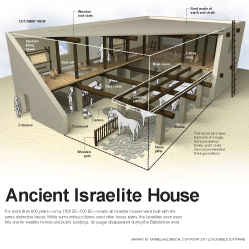19:1–15 Jeremiah receives instructions to carry out another sign-act, again using pottery as a symbol of Judah. His actions echo the symbolism from 18:1–12. In this sign-act, Jeremiah smashes the pot representing Judah to symbolize its imminent destruction at the hands of the Babylonians. This symbolic act has a greater impact on the people since it was witnessed by some leaders of Jerusalem. The judgment oracle accompanying the sign-act repeats the indictments against Israel for idol worship and child sacrifice (see 1:16; 2:20–37; 7:30–8:3). |
 Symbolic Actions of the Prophets Table
Symbolic Actions of the Prophets Table
19:1 a potter’s earthenware jar A generic ceramic jar (compare 1 Kgs 14:3).
19:2 the Valley of Ben Hinnom A site where child sacrifices took place. Also called “Gehenna.” See note on Jer 7:31.
the Gate of The location is uncertain since this name is used only here. It is probably to be identified with the Dung Gate, which was used for taking refuse out of Jerusalem. See Neh 2:13 and note.
19:3 Yahweh of hosts A title identifying God as leader of the heavenly armies—and also ultimately in authority over earthly armies. See note on Jer 6:6.
everyone who hears it, his ears The disaster will be so great that even those who are not directly affected will be impacted from hearing the news. Compare 1 Sam 3:11; 2 Kgs 21:12.
19:4 with the blood of the innocent Likely an allusion to the child sacrifice mentioned in Jer 19:5.
19:5 the high places of Baal Shrines devoted to Baal-worship. See note on Psa 78:58.
burn their children in the fire See Jer 7:31 and note. Compare 32:35; Lev 18:21.
19:6 the Valley of the Slaughter See Jer 7:32 and note.
19:8 a horror, and an object of hissing Compare 18:16.
19:9 I will cause them to eat the flesh of their sons They will resort to cannibalism due to the shortage of food from the siege (see Ezek 5:10 and note; compare Lam 2:20; 4:10; Isa 9:20).
the siege See Jer 6:6 and note; Ezek 4:2 and note.
19:11 I will break this people and this city Jeremiah breaks the jar and announces Yahweh’s resolve to break Judah for their apostasy.
19:13 where they made smoke offerings upon their roofs to all the host of heaven, and where The roof was the site of sacrifice to astral deities represented by sun, moon, and stars (see 2 Kgs 23:12; Zeph 1:5).
19:15 Yahweh of hosts See note on 6:6.
they have hardened their neck Judah’s persistent rebellion is a consistent theme in Jeremiah (see 5:3; 7:26; 8:5).

|
About Faithlife Study BibleFaithlife Study Bible (FSB) is your guide to the ancient world of the Old and New Testaments, with study notes and articles that draw from a wide range of academic research. FSB helps you learn how to think about interpretation methods and issues so that you can gain a deeper understanding of the text. |
| Copyright |
Copyright 2012 Logos Bible Software. |
| Support Info | fsb |
 Loading…
Loading…

